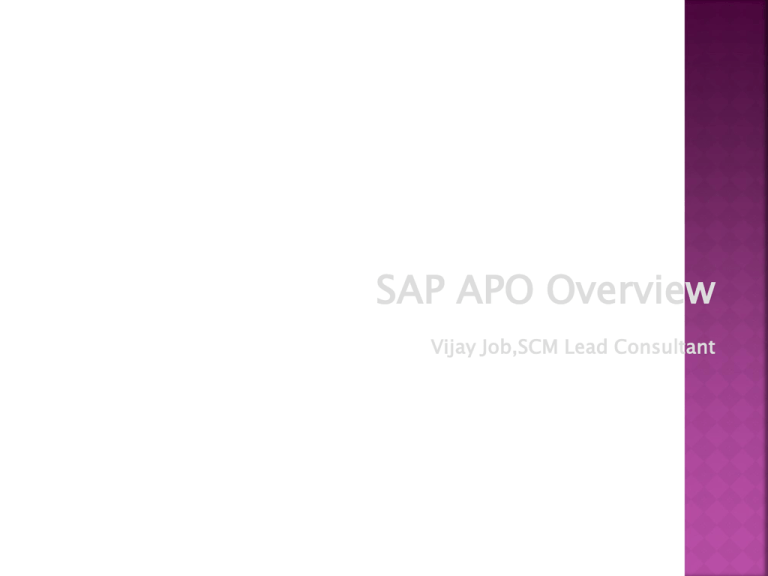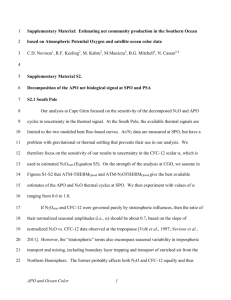SAP SCM APO Overview
advertisement

SAP APO Overview Vijay Job,SCM Lead Consultant Contents Supply Chain Management Why SCM over and above ERP Advantages of APO APO Architecture APO Components What is live Cache Data Mart Configuration InfoObjects Data Storage in APO Planning Architecture Master Planning Object Structure The Supply Chain: from Original Supply to Final Consumption INFORMATION FLOW Transfer Supplier Transfer Manufacturing Transfer Distribution Transfer Retail Outlet Consumer CASH FLOW Supply Chain Optimization Increase Customer Responsiveness at Least Cost R SAP AG Coined by consultant Keith Oliver, of strategy consulting firm Booz Allen Hamilton in 1982. Supply chain management (SCM) is the process of - planning, implementing and controlling the operations of the supply chain with the purpose to satisfy customer requirements as efficiently as possible. Begins and ends with the customer. SCM spans all movement and storage of raw materials, work-inprocess inventory, and finished goods from point-of-origin to point-of-consumption. Confidential © Copyright 2008 Wipro Ltd Supply chain management (SCM) is the process of planning, implementing, and controlling the operations of the supply chain with the purpose to satisfy customer requirements as efficiently as possible. Supply Chain Management encompasses the planning and management of all activities involved in sourcing, procurement, conversion, and logistics management activities. It includes coordination and collaboration with channel partners, which can be suppliers, intermediaries, third-party service providers, and customers. Supply Chain Management integrates supply and demand management within and across companies. Confidential © Copyright 2008 Wipro Ltd Innovation….Companies today are being forced to adapt to changes in the marketplace in order to preserve profitability Changing consumer buying patterns Evolving trade channel complexity Polarization of markets Shortened cycle times Shift in balance of power Increased number of SKUs Changing brand loyalty / retailer exerting greater influence Increased demand for value added programs VMI / custom packs Dramatically lower inventory levels and reduce working capital Improved customer service More accurate forecasting Lower cost sourcing of finished goods and raw materials Optimizing decisions in an increasingly complex business environment Reduce manufacturing cycle time Deliver reliability Responsiveness/ flexibility Supply chain activities can be grouped into: Strategic – Network optimization, partnerships, product design, IT infrastructure, Make or Buy decisions. Tactical – Sourcing, production & inventory decisions, Transportation strategy, benchmarking with competition Operational level – Daily production & distribution planning, master planning, production scheduling, forecasting and demand management. Confidential © Copyright 2008 Wipro Ltd APO Advanced Planning and Optimization is the planning component within the mySAP SCM solution. APO is an acronym for advanced planner and optimizer. This is a large component of sap's new dimension products. APO is an entire suite of supply chain planner applications that increase overall knowledge of the supply chain and provide forecasting, planning and optimization. APO is not a standalone application and requires a backend erp system such as SAP R/3 for the execution. SAP R/3 communicate with APO using the Core interface Functionality (CIF) which supplies SAP APO with the master and the transaction data in the real time 10 High performance using liveCache technology Global server: integrates multiple OLTP systems Collaborative planning via the internet Simultaneous material and finite capacity requirements planning Cross-plant optimization of the resource load Sequence and setup time optimization of orders Transportation optimization with route planning Evaluation and analysis of orders Seamless integration between APO and R/3 11 First Demand Planning - Of course R/3 provides Demand Management and also Statistical Forecasting tools. However the architecture in APO-DP is totally different and based on characteristic value combinations with liveCache for very fast data access. This allows easy aggregation and disaggregation. Moreover once you create the CVCs they can be modified easily with the associates transaction data using Realignment. The macro functionality in DP provides quick and user-friendly computations on the transaction data. Moreover the Statistical Forecasting toolset in APO-DP is more comprehensive to that in R/3. Not sure if MLR is possible in R/3. Promotion planning and Life-cycle planning are some nice features in APO-DP. Supply Network Planning in APO can be mapped to DRP in R/3. But then APO offers planning cross-plant for a complete supply chain network. SNP in APO offers basic Heuristic-based planning (quite similar to R/3 DRP) along with advanced planning features like Optimization and Capableto-Match (order-based planning for prioritized demand matching). Moreover Deployment and Transport Load Builder functionalities provides automatic planning in case of short supply followed by consolidation of deliveries according to transportation capacities. Simultaneous material planning and finite capacity planning of production, storage and transportation. Planning of critical components that use bottleneck resources. Cross plant optimization of resource utilization. Prioritization of requirements and receipts . Detailed distribution planning. Collective conversion of stock transfer requisitions. Decision support with What-If. Optimizes plan in line with business goals Seamless integration between APO and R/3 14 APO PPDS is very close to R/3 Production Planning functionalities and relies on the same set of master data transferred from R/3 to APO via CIF. However the multitude of Heuristics (both Production Planning and Scheduling) provides automation and gives more time to the Planners and Schedulers in focusing on more important tasks. The Detailed Scheduling functionality especially Planning Board in APO is a rich graphical and intuitive application for carrying out sequencing of activities. Likewise the Product Planning Table and Product Overview features of APO provides a cockpit view of the Production Plan and allows drilling down to exceptions. Cross plant planning: Production locations are connected, Products und Assemblies planned together Simultaneous material and capacity requirements planning Multi level capacity requirements planning; bi-directional propagation of order changes. Extensive detailed scheduling and optimization possibilities Global multi-site real time ATP. For production, ATP utilizes PP/DS functionality to check against the actual order network, thereby including all capacity constraints. Applying rules-based ATP is the basis for checking for alternative products in alternative locations as well as for considering production across all product levels. Integration with legacy system. Availa Supply Production Detailed ble Network Planning Scheduling Planning To Plannin Promis g e SC Cockpit APO liveCache Solvers Demand BW APO Application Link Enabling Model Generator, Mapping, Connectivity OLTP R/3 R/3 Legacy Non R\3 Non R\3 OLTP OLTP OLTP R/3 APO R/3 APO LIS Flexible Planning Standard SOP BW Demand Planning (DP) Global Available-toPromise (Global ATP) Sales Demand Management Material Requirements Planning (MRP) Capacity Requirements Planning (CRP) Supply Network Planning (SNP) Production Planning and Detailed Scheduling (PP/DS) SC Manufacturing / Procurement Transportation Planning & Vehicle Scheduling (TP/VS) Demand Planning (DP) Supply Network Planning (SNP) The Demand Planning component is a toolkit of statistical and collaborative forecasting techniques that helps you create accurate forecasts and plans Using the Supply Network Planning and Deployment component you can develop a model of your entire supply network and plan based on all its constraints Production Planning / Detailed Scheduling (PP/DS) This component can generate production plans and schedules that optimize resources Global Available To Promise (GATP) Transportation Planning / Vehicle Scheduling (TP/VS) The Global Available To Promise component uses a rules based strategy to ensure you can deliver what you promise to your customers This component helps you to select the optimum transportation route and schedules vehicle resources Supply Chain Cockpit (SCC) The Supply Chain Cockpit is a graphical instrument panel for modeling, navigating, and controlling all the links in the supply chain. Key Processes - Distribution Planning C u s t o m e r s Supply and Distribution Network Planning Supply Network Planning and Optimization Distribution Centers Supply/Demand balancing Vendor Managed Inventory (VMI) ManufacturIng Units R S u p p l i e r s SAP AG SNP Distribution Network Customer demands Distribution Centers Plants Suppliers R Transport Order SAP AG Production Order Available to Promise Global Rules Based Product Allocation Material Substitution Vendor Managed Inventory liveCache Technology Application Server Avoid disk I/O through shared, buffered data Hold all application data in memory Address large memories Ready to run on 64-bit systems ABAP-Application Program exec sql. Execute procedure “Schedule_order” ( OUT : var1, IN : table1, IN : var2) endexec. Optimized data structures Support application-specific data structures (e.g. store BOM as a tree rather than a relational table) Built-in business functionality Run application logic where the data is stored Aggregate OLTP database information in main memory SAP AG Optimized Method Coding Schedule_order Optimized Data Structures liveCache R Live cache Time series objects Data Stored in Bucket with no reference to order • Live cache Orders Data Stored with reference to the orders • Storage method suitable for operative planning • Storage method suitable for tactical planning • Usual method for saving current DP data • Confidential © Copyright 2008 Wipro Ltd Info Cube The data is stored in an Info cube • This storage method is suitable for data backups, old planning data and actual sales history • Info Object within BW Business evaluation objects are referred to as the Info objects in - the BW Info objects are divided into :- Characteristics Key figures Units Time Characteristics Info objects have three basic functions Component of an Info source, as a field of a structure Formation of an Info cube by representing key figures and characteristics Complete an info source with Master data and Hierarchies Planning objects are called as characteristics Characteristics are discrete names Standard characteristics are predefined in APO Custom characteristics can be created 33 Data is represented as a numerical value either a quantity or monetary value (Forecast, Safety Stock, etc..) Different data storage can be used to store key figure Standard key figures are predefined in APO Custom key figures can be created 34 Star Schema Properties 1. Data storage optimized for reporting by “Star Schema” 2. 3. 4. 5. One business process is modeled at a time Related Characteristics structured together in Dimensions The Key Figures, KPI’s and other calculations form the Facts This structure is the same for all Application Areas Example: Sales Data Model Queries that can be addressed are: Who did we sell to? • What did we sell? • Who sold it? • • Sales quantity? Who is our competitor? • • When did we sell? • Sales comparison • • Trends Reasons for Rejection Info Area Info Cubes Info Objects Catalogs Key Figures Characteristics Update Rules Info Source Metadata Transfer Rules R/3 Source System Legacy BW Excel APO Server InfoCubes Staging Engine Update Rules Communication structure Transformation rules Transfer Structure Transfer Structure InfoSource Transfer Structure Transfer Structure Extract Source Structure Extract Source Structure OLTP System 2 OLTP System 1 Master Planning Object Structure Planning Area 1 Planning Area 2 Planning Book 1 Planning Area n Planning Book 2… Data View 1 Data View 2…. Contains plannable characteristics for one or more planning area Specific characteristics are required for Supply Network Planning Structure on which all other planning object structures are based. Prerequisite for being able to create planning area 40 Pre-defined InfoObject can automatically be added Map existing InfoObjects to Planning Object Structure Central data structure Groups together parameters that define the scope of planning activities Determines where and how planning results are saved Contains Characteristics and Key Figures Maps where key figures for the planning area are stored (InfoCube, Orders in liveCache, Time Series in liveCache Planning Areas can be relevant for DP and SNP at the same time 42 Planning Area Administration Central point of control: Planning Area configuration Key Figure Characteristic Attribute Master Planning Object Structure Aggregate Storage Buckets Profile Planning Area











